|
TWO-DIMENSIONAL ART |
|
CHAPTER 1 |
Jean-Michel
Basquiat |
Picasso |
|
 |
|
Last Supper is a mural painted by Leonardo
da Vinci. It's located in the refectory of the Convent of
Santa Maria delle Grazie, Milan, and is a great example of
perspective and the use of triangles. |
DRAWING

Pietà per Vittoria Colonna
What do students learn from a good
drawing class? They learn how to see. That might seem like a
strange statement, but it's true, and it's the reason we
should continue to teach drawing, and not pull funding for
the subject. The best book on the subject is:
Drawing on the Right Side of the Brain by Betty Edwards
(Preview
this book »). This is the book that Disney and
Pixar use to teach their computer animators how to draw. It
was intended for people that think they have no talent, and
can never learn to draw.
It's important to realize
that the brain is active; it's not passive. In
other words, your brain takes information sent
to it by the senses, and constructs and
interprets reality. According to neuroscience,
the brain has two ways of perceiving and
processing reality – one verbal and analytic,
the other visual and perceptual. Edwards' method
of drawing suppresses the verbal analytical
tendency of viewing things. It
disregards our preconceived notions of what the
object should look like, and focuses on seeing
what's really there.
What do you think you see, when you look at an
object - lets say a person walking down the
street. What do you directly see? Think very
carefully now. Do you see a person walking - or
a
street? How could you actually see these things
directly? The theory is that we see light
reflected off objects; it passes through our
eyes, and an electrical signal is sent to the
brain. The brain then takes pixels of color, and
constructs a person
walking down the street. If you just focus on drawing,
or painting pixels, you would
immediately be able to create realistic
pictures.
Photorealism
Types of
Media for Drawing
Graphite:


| |
|
|
|
|
|
|
|
|
|
|
|
|
|
|
|
|
|
|
|
| 9H |
8H |
7H |
6H |
5H |
4H |
3H |
2H |
H |
F |
HB |
B |
2B |
3B |
4B |
5B |
6B |
7B |
8B |
9B |
|
Hardest |
> |
Medium |
> |
Softest |
From
Hardest to Softest
Pencils are made of
graphite. We refer to them as lead because
the first pencils were made of lead, and
graphite was originally thought to be a form
of lead. Actually it's the highest
grade of coal, but it's not used as fuel
because it's difficult to ignite.
England had the only pure deposit of graphite in the world.
It was used to make rounder cannonballs; that gave the
English navy an advantage as rounder projectiles fly
farther. They took what they needed, and flooded the mine
with water to prevent people from stealing the graphite.
When they needed more, they drained the mine.
Today we can refine impure graphite, and England
is no longer the only source.

Pencil Drawing by Jan Anders Nelson 1975-1976

Emanuele Dascanio
Charcoal:

Charcoal is produced by
heating wood in the absence of oxygen. The final result is
up to 98% carbon.
Charcoal can be smudged with your fingers - to achieve a
sense of volume, three-dimensionality, and dramatic
lighting. This is called chiaroscuro -
Italian for light and dark. A resin is then sprayed over the drawing
to fix the image.
View the drawings of Robert Longo:
Robert Longo – Charcoal Drawings
Chalk:


Chalk is a sedimentary rock that is formed
underwater. It's composed of calcium carbonate.
It can also be smudged with
your fingers - to achieve chiaroscuro.
Sidewalk Art (chalk and
Perspective) -
Video

Gaetano Gandolfi (1734–1802) Italian Baroque painter.
Cain and Abel - chalk on paper

Gaetano Gandolfi Seated
Male Nude - chalk on paper

Gaetano
Gandolfi (1734 - 1802) was an Italian painter of the late
Baroque and early Neoclassic period.
Pastel:


Pastels consist of powdered pigments in a
binder. These pigments are the same that are used in other
art media. Their colors are vibrant, and their name is also
used to describe the type of colors that pastels produce.
Pastels can also be smudge and worked
with the fingers, but they require no spray fixative.

Maurice Quentin de La Tour, Portrait of Louis XV
of France (1748)

Mary Cassatt - Sleepy Baby
1910

Edgar Degas - Ballet
Dancers in the Wings

Jean
Etienne Liotard
(1702 at Geneva – 1789 in Geneva)
Swiss-French painter -
Portrait of a Young Woman
WET MEDIA
Pen and Ink:
Different
intensities can be created by diluting the ink.

Amedeo Modigliani - Ritratto di Donna Rossa
Pen and Ink

Michelangelo

Michelangelo Buonarroti - Satyr's Head
Bistre Ink was made by boiling
large quantities of wood creosote (chimney
soot). The preferred wood is beech, and the
resulting ink is silky smooth - with warn
golden brown colors.
Wash and
Brush:
Ink is diluted
with water, and washed onto paper with a brush.

PAINTING
Watercolor:
Watercolor paint is fast drying, transparent, and is diluted
with water.


Albrect Durer - A Young Hare, 1502 - watercolor

Van Goh 1883
Acrylic:
The pigments of acrylic paint are suspended
in an acrylic polymer emulsion. The paint is water soluble,
and when diluting, the media is like watercolors.
The paint is inferior because it's fast
drying. Recent advancements have made this media as durable
as oil paint.
Oil Paint:
The pigments of oil paint are
suspended in linseed oil. It can be diluted with linseed
oil, turpentine, or varnish; varnish creates a glossy
finish. Technically the oil never fully dries.
Oil is slow to dry, so the
artist has ample time to work the paint, or wipe the
paint off the canvass. Intense details, shading, and
chiaroscuro can be created with this paint. Photo realism
became possible with the invention of this media.

Oil Painting, "Pressure #1", 40" x 60" on canvas, 2017
by Jan Anders Nelson

The Mona Lisa, by Leonardo da
Vinci

Landscape by Chen Chengpo, 1933
Note: Chinese oil painting is not a common
practice.

Both Members of This Club George Bellows
Fresco:
Learn about Michelangelo's fresco technique.
In buon fresco pigments are mixed with water,
and applied on wet lime mortar. The plaster serves as a
binder. Because the plaster dries fast, this technique is
done in sections. Colors are limited, because some pigments
don't react well with lime.
Secco frescos are painted on dry plaster, so
the
pigments require a binder. Egg tempera was the most
common paint used. Secco work is often done on top of a buon
fresco to: give the work more detail, add a color
unavailable with buon fresco (blue for example), and to
correct mistakes. Unfortunately secco frescos don't last as
long.

Michelangelo's
Sistine Chapel (1508-1512)
What type of fresco did he
use here?




Was
buon or secco used above?
Collaborate:
Tempera:
Tempera is a fast drying paint, durable, and
long lasting. Pigments are mixed with egg yolks, glue,
or gum. This was replaced by the invention of oil paint.

Franz Marc - Red and Blue Horses, 1912,
Tempera on Paper
Franz Marc (1880 – 1916) was a German painter and
printmaker. He was one of the key figures of the German
Expressionist movement.
PRINTING
Relief
Etching:

In relief etching groves
are cut into a plate or wood block (matrix). Ink is
applied to the surface, and paper is pressed onto the
surface. The ink on the raised areas transfers onto the
paper. The cut out areas become the negative space.
Thirty-six Views of Mount Fuji
Woodblock
Katsushika
Hokusai, Japan (1760–1849)
| № |
Image |
English title |
Japanese title |
|
1 |
 |
The Great Wave off
Kanagawa |
神奈川沖浪裏
Kanagawa oki
nami-ura |
|
2 |
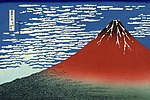 |
South Wind, Clear
Sky (also known as
Red Fuji) |
凱風快晴
Gaifū kaisei |
|
3 |
 |
Rainstorm Beneath
the Summit |
山下白雨
Sanka hakū |
|
4 |
 |
Under Mannen
Bridge at Fukagawa |
深川万年橋下
Fukagawa
Mannen-bashi shita |
|
5 |
 |
Sundai, Edo |
東都駿台
Tōto sundai |
|
6 |
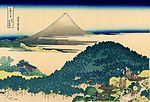 |
The Blue Mountain
and Circle of Pine Trees |
青山円座松
Aoyama
enza-no-matsu |
|
7 |
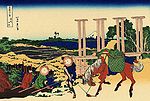 |
Senju, Musashi
Province |
武州千住
Bushū Senju |
|
8 |
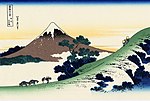 |
Inume Pass, Kōshū |
甲州犬目峠
Kōshū inume-tōge |
|
9 |
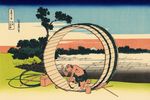 |
Fuji View Field in
Owari Province |
尾州不二見原
Bishū Fujimigahara |
|
10 |
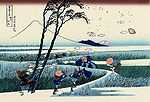 |
Ejiri in the
Suruga Province |
駿州江尻
Sunshū Ejiri |
|
11 |
 |
A sketch of the
Mitsui shop in
Suruga in
Edo |
江都駿河町三井見世略図
Kōto Suruga-cho
Mitsui Miseryakuzu |
|
12 |
 |
Sunset across the
Ryōgoku bridge from
the bank of the
Sumida River at
Onmayagashi |
御厩川岸より両国橋夕陽見
Ommayagashi yori
ryōgoku-bashi yūhi mi |
|
13 |
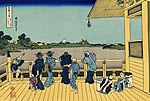 |
Sazai hall - Temple
of Five Hundred
Rakan |
五百らかん寺さざゐどう
Gohyaku-rakanji
Sazaidō |
|
14 |
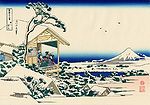 |
Tea house at
Koishikawa. The
morning after a snowfall |
礫川雪の旦
Koishikawa yuki no
ashita |
|
15 |
 |
Below
Meguro |
下目黒
Shimo-Meguro |
|
16 |
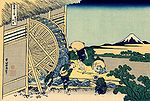 |
Watermill at Onden |
隠田の水車
Onden no suisha |
|
17 |
 |
Enoshima in
Sagami Province |
相州江の島
Soshū Enoshima |
|
18 |
 |
Shore of Tago Bay,
Ejiri at
Tōkaidō |
東海道江尻田子の浦略図
Tōkaidō Ejiri
tago-no-ura |
|
19 |
 |
Yoshida at
Tōkaidō |
東海道吉田
Tōkaidō Yoshida |
|
20 |
 |
The
Kazusa Province sea
route |
上総の海路
Kazusa no kairo |
|
21 |
 |
Nihonbashi bridge in
Edo |
江戸日本橋
Edo Nihon-bashi |
|
22 |
 |
Barrier Town on
the
Sumida River |
隅田川関屋の里
Sumidagawa Sekiya
no sato |
|
23 |
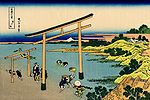 |
Bay of Noboto |
登戸浦
Noboto-ura |
|
24 |
 |
The lake of
Hakone in
Sagami Province |
相州箱根湖水
Sōshū Hakone kosui |
|
25 |
 |
Mount Fuji reflects
in
Lake Kawaguchi, seen
from the Misaka Pass in
Kai Province |
甲州三坂水面
Kōshū Misaka
suimen |
|
26 |
 |
Hodogaya on the
Tōkaidō |
東海道保ケ谷
Tōkaidō Hodogaya |
|
27 |
 |
Tama River in
Musashi Province |
武州玉川
Bushū Tamagawa |
|
28 |
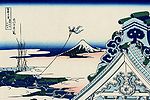 |
Asakusa Hongan-ji
temple in the Eastern
capital [Edo] |
東都浅草本願寺
Tōto Asakusa
honganji |
|
29 |
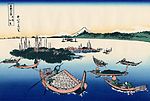 |
Tsukuda Island in
Musashi Province |
武陽佃島
Buyō Tsukuda-jima |
|
30 |
 |
Shichiri beach in
Sagami Province |
相州七里浜
Soshū
Shichiri-ga-hama |
|
31 |
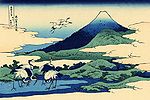 |
Umegawa in
Sagami Province |
相州梅沢庄
Soshū umezawanoshō |
|
32 |
 |
Kajikazawa in
Kai Province |
甲州石班沢
Kōshū Kajikazawa |
|
33 |
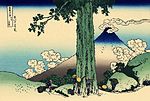 |
Mishima Pass in
Kai Province |
甲州三嶌越
Kōshū Mishima-goe |
|
34 |
 |
Mount Fuji from the
mountains of
Tōtōmi |
遠江山中
Tōtōmi sanchū |
|
35 |
 |
Lake Suwa in
Shinano Province |
信州諏訪湖
Shinshū Suwa-ko |
|
36 |
 |
Ushibori in
Hitachi Province |
常州牛掘
Jōshū Ushibori |
Additional 10
| № |
Image |
English title |
Japanese title |
|
1 |
 |
Goten-yama-hill,
Shinagawa on the
Tōkaidō |
東海道品川御殿山の不二
Tōkaidō Shinagawa
Goten'yama no Fuji |
|
2 |
 |
Honjo Tatekawa, the
timberyard at
Honjo |
本所立川
Honjo Tatekawa |
|
3 |
 |
Pleasure District at
Senju |
従千住花街眺望の不二
Senju Hana-machi
Yori Chōbō no Fuji |
|
4 |
 |
Nakahara in
Sagami Province |
相州仲原
Sōshū Nakahara |
|
5 |
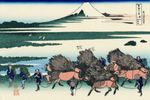 |
Ōno Shinden in the
Suruga Province |
駿州大野新田
Sunshū Ōno-shinden |
|
6 |
 |
Climbing on Fuji |
諸人登山
Shojin tozan |
|
7 |
 |
The Tea plantation
of Katakura in
Suruga Province |
駿州片倉茶園の不二
Sunshū Katakura
chaen no Fuji |
|
8 |
 |
The Fuji from
Kanaya on the
Tōkaidō |
東海道金谷の不二
Tōkaidō Kanaya no
Fuji |
|
9 |
 |
Dawn at
Isawa in
Kai Province |
甲州伊沢暁
Kōshū Isawa no
Akatsuki |
|
10 |
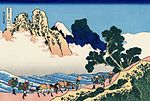 |
The back of Fuji
from the Minobu river |
身延川裏不二
Minobu-gawa ura
Fuji |
MOVABLE TYPE PRINTING

Johannes Gutenberg
(1398–1468) was a German goldsmith, printer, and
publisher. He invented movable type printing in
1439. The design of his press was taken from the
wine screw presses at the time - see picture
below. Before the invention of movable type,
books were handwritten, or they were printed
using the woodblock method.

WINE PRESS

Gutenberg Press

Movable Type
Intaglio
(in-TAL-ee-oh):

Intaglio printing is the opposite of relief printing. The plate
is inked, and the surface is wiped clean, so ink remains in
the etched groves. Dampened paper is pressed onto the plate
under great pressure - to force the paper into the groves.
The ink in the groves transfers onto the paper.
This process can be done
by cutting groves into the plate, or a resin can be applied
to the matrix. Paper is placed on top of the matrix, and a
drawing is done. Where the artist has drawn, the resin
transfers onto the paper - leaving the metal plate exposed.
The plate is soaked in acid, and the exposed areas are
etched. The longer the plate is left in the acid, the deeper
the groves, and the darker the printed area.



Printed Circuit
Board
Click to learn how to aluminum foil and white
vinegar
Planographic
Printing:
The artist paints ink onto
a flat unetched metal plate. Paper is pressed onto the
plate. This creates a single onetime print.
Lithography:

Johann Alois Senefelder
(1771–1834) was a German actor and playwright.
Her invented lithography in 1796.
VIDEO
Lithography is a planographic processes of printing
that uses a limestone matrix. The name comes from litho for
stone - and graph to draw. The artist draws onto the stone
with grease. Water is pored on the stone, and it's absorbed
where there is no grease. An oil-based ink is applied to the
surface. It's repelled by the water, and sticks to the
grease.
Lithographs produce tiny dots of color, and trick the eye
into seeing continuous tones.
Giclée Printing:
The word giclée (zhee-clay)
is derived from the French word "gicler" to spray. Giclée is
a process of sprayed ink. The resolution is far greater
because when the ink is sprayed onto paper or canvass, and
the colors blend together creating continuous tones.
Collage
Wangechi Mutu
|

Juan Gris, The Sunblind,
1914,
Tate Gallery |

Henri Matisse,
Beasts of the Sea, 1950,
paper collage on canvas |

Henri Matisse,
The Sorrows of the King,
1952,
Gouache on paper and canvas,
Pompidou Centre,
Paris |
|
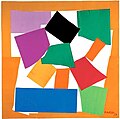
Henri Matisse ,
The Snail, 1953,
Gouache on paper, cut and
pasted, on white paper
Tate Gallery |

Richard Hamilton,
John McHale, Just What Is It
That Makes Today’s Homes So
Different, So Appealing? 1956,
collage, (one of the earliest works
to be considered
Pop Art) |

Tom Wesselmann, Still Life
#20,
mixed media, collage, 1962,
Albright-Knox Art Gallery
Buffalo, New York |
|

Compotier avec fruits, violon
et verre by
Pablo Picasso (1912) |

Henri Matisse ,
Blue Nude II, 1952,
gouache
découpée,
Pompidou Centre,
Paris |

Cecil Touchon, Fusion Series
#2174, Collage on Paper,
billboard material |
Old
Assignment
Examples by John Chiappone
      
Visit the Student Gallery
ELEMENTS OF
ART
View the Class ART Gallery
PRINCIPLES OF
ART
Guide
PERSPECTIVE

|
LINEAR
PERSPECTIVE
|
.png/120px-Perspective_(PSF).png)
|
 |
|
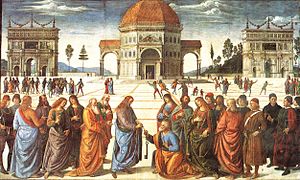 |
|
SHIFTING PERSPECTIVE

Ma Yüan (c. 1160–1225)
(Peasants Returning from Work)
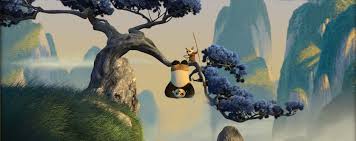
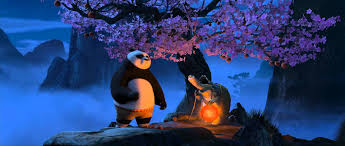
Perspective in Kung
Fu Panda
|

Landscape With Palace
Japanese, Edo period
Tozaka Bun`yo, 1783–1852 |
|
ATMOSPHERIC
PERSPECTIVE
River in a Mountain Landscape by
John Mix Stanley |
|
 |
|
CHIAROSCURO

John
Chiappone
2010
Shifting Shapes
In the
above picture I used shadows to
create depth.
Chiaroscuro is Italian for light and Shade.
Chiaroscuro creates a 3-d quality,
but in the movie
Renaissance
only black and white is used. This
lack of variation creates a flat
look, and great contrast.
This video demonstrates chiaroscuro,
grisaille (monotone underpainting),
and color glazing.
View Video |
|
Michelangelo Merisi da Caravaggio
|
 |
|
Michelangelo Merisi da Caravaggio
(September 28, 1573 – July 18,
1610)
Italian Baroque painter
|
|
The Calling of Saint Matthew
|
Caravaggio
by Ottavio Leoni
|
Flagellazione di Cristo, 1607
|
|
Crocifissione di sant'Andrea,
1607-1608
|

Medusa |
The Conversion on the Way to Damascus
|

Crucifixion of Peter |

Cupid (1602) |

John the Baptist
(Youth with a Ram), 1602
|
|
DYNAMICS
|
|
Triangles:
Rudolf Bauer (1889 –
1953) German abstract artist
Frank
Frazetta
(1928 – 2010) American fantasy and
science fiction
|
|
PHOTOGRAPHY
Camera Obscura:

Camera obscura is Latin for dark room.
It projects an image of its surroundings through a
pinhole onto a screen. It was used to draw accurate
images - and to experiment with light.
The Chinese had camera obscuras and was
described by the Han Chinese polymathic genius Shen Kuo,
an ancient Chinese polymath, described the camera
obscura in his scientific book Dream Pool Essays (1088
C.E.) Aristotle had discussed the basic principle behind
it in his Problems.

Born 1031
Qiantang
Died 1095
His fields of study: Geology, Astronomy, Archaeology,
Mathematics, Pharmacology, Magnetics, Optics,
Hydraulics, Metaphysics, Meteorology, Climatology,
Geography, Cartography, Botany, Zoology, Architecture,
Agriculture, Economics, Military strategy, Ethnography,
and Music.
Shen Kuo was known for Geomorphology, Climate change,
Atmospheric refraction, True north, Retrogradation,
Camera obscura, Raised-relief map, fixing the position
of the pole star, and correcting lunar and solar
errors.

The Arab scientist Alhazen (965–1039 AD)
built a camera obscura. AD refers to Anno
Domini - in the year of our/the Lord. Alhazen's
work is the first clear description, outside of China,
of the camera obscura.
Pinhole Camera:
A pinhole camera is a small camera obscura with photo
sensitive paper on the back wall.
VIDEO
http://www.wikihow.com/Make-a-Pinhole-Camera
Photographic Process:
William Henry Fox Talbot (1800 –
1877) invented the photographic process.

William Henry Fox Talbot, 1864

Latticed window at Lacock Abbey, 1835
This was from the oldest negative in existence.
|
 |
Pencil of Nature

Talbot's book Pencil of Nature was published
between 1844 and 1846. It was the first book
with photographic illustrations ever
commercially published.
|
|
 |
|
 |
|
Cameraless Photography
|
|
Cyanotypes

Sir John Herschel
(7 March 1792 – 11 May 1871) was an
English polymath: photographer, inventor, chemist,
mathematician, botanist, and astronomer. He made
improvements in the photography, and invented the
cyanotype process.
Cyanotype is a
photographic printing process that produces a cyan-blue
print. Engineers used the process well into the 20th
century to produce blueprints. Two chemicals, ammonium
iron(III) citrate and potassium ferricyanide, are
painted onto paper; objects sre plsced on the paper, and
exposed to light.
Anna
Atkins
(1799 – 1871) was an English botanist, photographer, and the
first person to publish a book illustrated exclusively with
photographic images.
Sir John Herschel, a
friend of Atkins and her father, invented the cyanotype
photographic process in 1842. Anna applied
the process to solve the difficulties of making accurate
drawings of scientific specimens. She self-published the
first photographic book - British Algae: Cyanotype Impressions.
Only about twelve copies of the book were made, one of which
is held in the National Media Museum in Bradford, England.
She continued to publish other installments of the
British Algae series, and also to make other books like
Cyanotypes of British and Foreign Flowering Plants and
Ferns (1854.
View Anna Atkins
|
|
|
 |
|
|
 |
|
|

|
|

|
 |
|

|

|
|
A
photogram is a photographic image made
without a camera by placing objects directly
onto the surface of a photo-sensitive
material such as photographic paper, and
then exposing it to light. The result is a
negative shadow image varying in tone,
depending on the transparency of the objects
used. Areas of the paper that have received
no light appear white; those exposed through
transparent or semi-transparent objects
appear grey.
This method of imaging is perhaps most
prominently attributed to Man Ray and his
exploration of rayographs. Others who have
experimented with the technique include
László Moholy-Nagy, Christian Schad (who
called them "Schadographs"), Imogen
Cunningham and even Pablo Picasso.
Man Ray (1890
– 1976) was an American artist who spent most
of his career in Paris. He helped establish the Dada, Surrealist,
and avant-garde movements. He is noted for his photograms - which he renamed
rayographs. ARTnews magazine named him one of the 25 most
influential artists of the 20th century. |
|
 |
Man
Ray
|
|
|
Rayagraphs |
 |
|

|
|
|
Scanagraphs:
   
Scanagraphs were created by John Chiappone as a way to teach
composition and cameraless photography. Create your own scanagraph by placing objects on a scanner
or copy machine. See the extra credit assignments on the
Blackboard site.
|
|

Abraham Lincoln as
U.S. Congressman-elect in 1846
by Nicholas H. Shepard
Daguerreotype Photography
The
daguerreotype photographic
process was not
the first, but it was the first to come into
widespread use (1840s-1860s). The images are on
a metallic silver surface. The image
disappears when being viewed from certain
angles.
|
Straight
Photography:

Alfred Stieglitz
Self Portrait, 1886 |
   |
 


 |
|
 |
|
Alfred
Stieglitz
(1864–1946) was an American
photographer who founded Straight
Photography. Straight Photography
is realistic - with sharp focus. They
reject soft focus and manipulation.
Stieglitz used his New York galleries to advance
photography and avant-garde art as legitimate. His wife
was the famous painter Georgia O'Keeffe. |
|
 |
 
 |

 |
 |
ANSEL ADAMS
(1902 – 1984)
Ansel
Easton Adams was an straight photographer and
environmentalist. The clarity and depth of his pictures are
owed to his
view
camera.
He is best known for his
black-and-white photographs of Yosemite National Park.

Ansel Adams - Evening McDonald Lake, Glacier National
Park
|
 |
 |
 |
 |
 |
 |
 |
 |
 |
 |
 |
 |
 |
 |
 |
 |
 |
 |
 |
 |
 |
 |
 |
 |
 |
 |
 |
 |
 |
 |
 |
 |
 |
 |
 |
 |
 |
 |
|
Most Expensive
Photographs

Untitled #96 is a
photograph by American artist Cindy Sherman in 1981. In
2011, a print was auctioned for $3.89 million, making it
the most expensive photograph ever sold at that time.
Read:
The Making of an Artist

Rhein II is a
photograph made by German visual artist Andreas Gursky
in 1999. In 2011, a print was auctioned for $4.3 million
(then £2.7m), making it the most expensive photograph
ever sold to date.
What makes a work of
art so expensive? It's the provenance (ownership
or location). Establishing the provenance is a matter of
documentation.
Nazi Propaganda Photo

Hessy Levinsons Taft (born 17 May 1934)
is a woman, born to Jewish parents in Berlin, best known
for having been featured prominently as an infant in
Nazi propaganda after her photo was surreptitiously
entered in, and then selected as the winner of, a
contest to find the most beautiful Aryan baby. Taft's
image became one of the most subversive of the 20th
century when it was distributed widely by the Nazi party
in a variety of materials, such as magazines and
postcards, to promote Aryanism. Her parents, Jacob and
Pauline Levinsons, were unaware of their photographer's
decision to enter the photograph into the contest until
learning that the photo of their daughter had been
selected by Nazi Propaganda Minister Joseph Goebbels as
the winner of the contest. Fearing that the Nazis would
discover that their family was Jewish, Taft's mother
informed the photographer that they were Jewish. The
photographer told her mother, Pauline, that he knew they
were Jewish and deliberately entered Taft's photograph
into the contest because he wanted to show that the
Nazis were ridiculous. Taft said, "I can laugh about it
now, but if the Nazis had known who I really was, I
wouldn't be alive." She is now a chemistry professor in
New York.
|
YATIN
This is an example of what straight photography was
against.
Documentary Photography:
TANK MAN VIDEO
Photo by
Jeff Widener (Associated
Press), June 5, 1989.
The image is one of the most
famous symbols of the 20th century. An anonymous
man stopped a column of tanks in Beijing after
the Chinese military forcibly removed protestors
from Tiananmen Square the day before. See World
Press Photos for more like this.
Ashes and Snow by
Canadian artist
Gregory Colbert is an installation of
photographic artworks, films, and a novel in
letters that travels in the
Nomadic Museum, a temporary structure
built exclusively to house the exhibition.
The work explores the shared poetic
sensibilities of human beings and animals.
To date, Ashes and Snow has attracted more
than 10 million visitors, making it the most
attended exhibition by a living artist in
history.
CONCRETE
PHOTOGRAPHY
Erika Blumenfeld
Erica
photographs light.
S T U D E N T G A L L E R Y
photography
ART APPRECIATION
Tom Shannon
The painter and the pendulum
Francis Bacon :
Three Studies for Figures at the Base of a
Crucifixion
RADIOLAB - ON MEMORY
http://www.joeandoe.com
Wangechi Mutu
FUNNY
Pulitzer Prize
Editorial Cartooning
CHILD PRODIGY
Marla Olmstead
Alexandra Nechita
EBOOKS
THE PRACTICE & SCIENCE OF DRAWING
BY HAROLD SPEED
|
|
|

